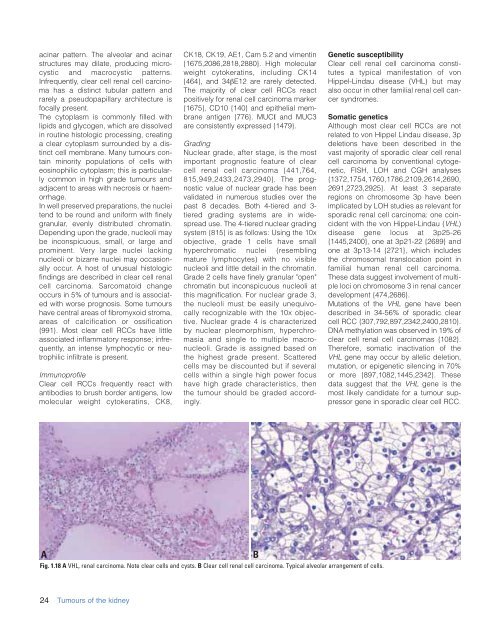Eble JN, Sauter G., Epstein JI, Sesterhenn IA - iarc
Eble JN, Sauter G., Epstein JI, Sesterhenn IA - iarc
Eble JN, Sauter G., Epstein JI, Sesterhenn IA - iarc
You also want an ePaper? Increase the reach of your titles
YUMPU automatically turns print PDFs into web optimized ePapers that Google loves.
acinar pattern. The alveolar and acinar<br />
structures may dilate, producing microcystic<br />
and macrocystic patterns.<br />
Infrequently, clear cell renal cell carcinoma<br />
has a distinct tubular pattern and<br />
rarely a pseudopapillary architecture is<br />
focally present.<br />
The cytoplasm is commonly filled with<br />
lipids and glycogen, which are dissolved<br />
in routine histologic processing, creating<br />
a clear cytoplasm surrounded by a distinct<br />
cell membrane. Many tumours contain<br />
minority populations of cells with<br />
eosinophilic cytoplasm; this is particularly<br />
common in high grade tumours and<br />
adjacent to areas with necrosis or haemorrhage.<br />
In well preserved preparations, the nuclei<br />
tend to be round and uniform with finely<br />
granular, evenly distributed chromatin.<br />
Depending upon the grade, nucleoli may<br />
be inconspicuous, small, or large and<br />
prominent. Very large nuclei lacking<br />
nucleoli or bizarre nuclei may occasionally<br />
occur. A host of unusual histologic<br />
findings are described in clear cell renal<br />
cell carcinoma. Sarcomatoid change<br />
occurs in 5% of tumours and is associated<br />
with worse prognosis. Some tumours<br />
have central areas of fibromyxoid stroma,<br />
areas of calcification or ossification<br />
{991}. Most clear cell RCCs have little<br />
associated inflammatory response; infrequently,<br />
an intense lymphocytic or neutrophilic<br />
infiltrate is present.<br />
Immunoprofile<br />
Clear cell RCCs frequently react with<br />
antibodies to brush border antigens, low<br />
molecular weight cytokeratins, CK8,<br />
CK18, CK19, AE1, Cam 5.2 and vimentin<br />
{1675,2086,2818,2880}. High molecular<br />
weight cytokeratins, including CK14<br />
{464}, and 34βE12 are rarely detected.<br />
The majority of clear cell RCCs react<br />
positively for renal cell carcinoma marker<br />
{1675}, CD10 {140} and epithelial membrane<br />
antigen {776}. MUCΙ and MUC3<br />
are consistently expressed {1479}.<br />
Grading<br />
Nuclear grade, after stage, is the most<br />
important prognostic feature of clear<br />
cell renal cell carcinoma {441,764,<br />
815,949,2433,2473,2940}. The prognostic<br />
value of nuclear grade has been<br />
validated in numerous studies over the<br />
past 8 decades. Both 4-tiered and 3-<br />
tiered grading systems are in widespread<br />
use. The 4-tiered nuclear grading<br />
system {815} is as follows: Using the 10x<br />
objective, grade 1 cells have small<br />
hyperchromatic nuclei (resembling<br />
mature lymphocytes) with no visible<br />
nucleoli and little detail in the chromatin.<br />
Grade 2 cells have finely granular "open"<br />
chromatin but inconspicuous nucleoli at<br />
this magnification. For nuclear grade 3,<br />
the nucleoli must be easily unequivocally<br />
recognizable with the 10x objective.<br />
Nuclear grade 4 is characterized<br />
by nuclear pleomorphism, hyperchromasia<br />
and single to multiple macronucleoli.<br />
Grade is assigned based on<br />
the highest grade present. Scattered<br />
cells may be discounted but if several<br />
cells within a single high power focus<br />
have high grade characteristics, then<br />
the tumour should be graded accordingly.<br />
Genetic susceptibility<br />
Clear cell renal cell carcinoma constitutes<br />
a typical manifestation of von<br />
Hippel-Lindau disease (VHL) but may<br />
also occur in other familial renal cell cancer<br />
syndromes.<br />
Somatic genetics<br />
Although most clear cell RCCs are not<br />
related to von Hippel Lindau disease, 3p<br />
deletions have been described in the<br />
vast majority of sporadic clear cell renal<br />
cell carcinoma by conventional cytogenetic,<br />
FISH, LOH and CGH analyses<br />
{1372,1754,1760,1786,2109,2614,2690,<br />
2691,2723,2925}. At least 3 separate<br />
regions on chromosome 3p have been<br />
implicated by LOH studies as relevant for<br />
sporadic renal cell carcinoma: one coincident<br />
with the von Hippel-Lindau (VHL)<br />
disease gene locus at 3p25-26<br />
{1445,2400}, one at 3p21-22 {2689} and<br />
one at 3p13-14 {2721}, which includes<br />
the chromosomal translocation point in<br />
familial human renal cell carcinoma.<br />
These data suggest involvement of multiple<br />
loci on chromosome 3 in renal cancer<br />
development {474,2686}.<br />
Mutations of the VHL gene have been<br />
described in 34-56% of sporadic clear<br />
cell RCC {307,792,897,2342,2400,2810}.<br />
DNA methylation was observed in 19% of<br />
clear cell renal cell carcinomas {1082}.<br />
Therefore, somatic inactivation of the<br />
VHL gene may occur by allelic deletion,<br />
mutation, or epigenetic silencing in 70%<br />
or more {897,1082,1445,2342}. These<br />
data suggest that the VHL gene is the<br />
most likely candidate for a tumour suppressor<br />
gene in sporadic clear cell RCC.<br />
A<br />
B<br />
Fig. 1.18 A VHL, renal carcinoma. Note clear cells and cysts. B Clear cell renal cell carcinoma. Typical alveolar arrangement of cells.<br />
24 Tumours of the kidney

















